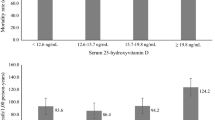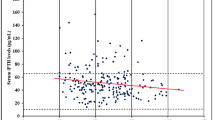Abstract
Vitamin D is associated with cardiovascular disease and renal function but the mechanisms are as yet unexplained. Microalbuminuria is associated with a higher risk of kidney function loss, cardiovascular disease, and mortality. Parathyroid hormone is a predictor of cardiovascular mortality and negatively correlated with glomerular filtration rate. We investigated the association between vitamin D status and 5-year changes in urine albumin creatinine ratio (UACR) and parathyroid hormone (PTH). A random sample of 6,784 individuals aged 30−60 years from a general population participated in the Inter99 study in 1999–2001. Vitamin D (serum-25-hydroxyvitamin D) was measured at baseline by high-performance liquid chromatography. UACR and PTH were measured at baseline and follow-up. Increased UACR was defined as UACR >4.0 mg/g reflecting the upper quartile at baseline. We included 4,330 individuals who participated at 5-year follow-up. In multivariable linear regression analysis, a 10-nmol/l higher baseline level of vitamin D was associated with a 5-year decrease in UACR by 0.92 % (95 % confidence interval, CI 0.13, 1.71). In multivariable logistic regression analysis, the odds ratio of developing increased UACR during follow-up was 0.96 (95 % CI 0.92, 0.98) per 10 nmol/l higher baseline vitamin D level. We found a significant inverse cross-sectional (p < 0.0001) but no prospective association (p = 0.6) between baseline vitamin D status and parathyroid hormone. We found low vitamin D status to be a predictor of long-term development of increased UACR. It remains to be proven whether vitamin D deficiency is a causal and reversible factor in the development of albuminuria.
Similar content being viewed by others

References
L.G. Danescu, S. Levy, J. Levy, Vitamin D and diabetes mellitus. Endocrine 35, 11–17 (2009)
M.F. Holick, Vitamin D deficiency. N. Engl. J. Med. 357, 266–281 (2007)
P. Greenland, J.S. Alpert, G.A. Beller, E.J. Benjamin, M.J. Budoff et al., 2010 ACCF/AHA guideline for assessment of cardiovascular risk in asymptomatic adults: a report of the American College of Cardiology Foundation/American Heart Association Task Force on Practice Guidelines. J. Am. Coll. Cardiol. 56, e50–e103 (2010)
H.J. Lambers Heerspink, J.W. Brinkman, S.J. Bakker, R.T. Gansevoort, de ZD, Update on microalbuminuria as a biomarker in renal and cardiovascular disease. Curr. Opin. Nephrol. Hypertens. 15, 631–636 (2006)
C.S. Sheng, B.C. Hu, W.X. Fan, J. Zou, Y. Li et al., Microalbuminuria in relation to the metabolic syndrome and its components in a Chinese population. Diabetol. Metab. Syndr. 3, 6 (2011)
de ZD, G. Remuzzi, H.H. Parving, W.F. Keane, Z. Zhang et al., Albuminuria, a therapeutic target for cardiovascular protection in type 2 diabetic patients with nephropathy. Circulation 110, 921–927 (2004)
H. Ibsen, M.H. Olsen, K. Wachtell, K. Borch-Johnsen, L.H. Lindholm et al., Reduction in albuminuria translates to reduction in cardiovascular events in hypertensive patients with left ventricular hypertrophy and diabetes. J. Nephrol. 21, 566–569 (2008)
I.H. de Boer, G.N. Ioannou, B. Kestenbaum, J.D. Brunzell, N.S. Weiss, 25-Hydroxyvitamin D levels and albuminuria in the Third National Health and Nutrition Examination Survey (NHANES III). Am. J. Kidney Dis. 50, 69–77 (2007)
Z.D. de, R. Agarwal, M. Amdahl, P. Audhya, D. Coyne et al., Selective vitamin D receptor activation with paricalcitol for reduction of albuminuria in patients with type 2 diabetes (VITAL study): a randomised controlled trial. Lancet 376, 1543–1551 (2010)
L. Steingrimsdottir, O. Gunnarsson, O.S. Indridason, L. Franzson, G. Sigurdsson, Relationship between serum parathyroid hormone levels, vitamin D sufficiency, and calcium intake. JAMA 294, 2336–2341 (2005)
E. Hagstrom, P. Hellman, T.E. Larsson, E. Ingelsson, L. Berglund et al., Plasma parathyroid hormone and the risk of cardiovascular mortality in the community. Circulation 119, 2765–2771 (2009)
H. Reichel, B. Deibert, H. Schmidt-Gayk, E. Ritz, Calcium metabolism in early chronic renal failure: implications for the pathogenesis of hyperparathyroidism. Nephrol. Dial. Transpl. 6, 162–169 (1991)
S. Ozmen, R. Danis, D. Akin, T. Cil, O. Yazanel, Parathyroid hormone as a marker for the differential diagnosis of acute and chronic renal failure. Ren. Fail. 29, 509–512 (2007)
K/DOQI, Clinical practice guidelines for bone metabolism and disease in chronic kidney disease. Am. J. Kidney Dis. 42, S1–S201 (2003)
C.M. O’Seaghdha, S.J. Hwang, R. Holden, S.L. Booth, C.S. Fox, Phylloquinone and vitamin D Status: associations with incident chronic kidney disease in the framingham offspring cohort. Am. J. Nephrol. 36, 68–77 (2012)
T. Jorgensen, K. Borch-Johnsen, T.F. Thomsen, H. Ibsen, C. Glumer et al., A randomized non-pharmacological intervention study for prevention of ischaemic heart disease: baseline results Inter99. Eur. J. Cardiovasc. Prev. Rehabil. 10, 377–386 (2003)
U. Toft, L. Kristoffersen, S. Ladelund, A. Bysted, J. Jakobsen et al., Relative validity of a food frequency questionnaire used in the Inter99 study. Eur. J. Clin. Nutr. 62, 1038–1046 (2008)
T. Skaaby, L.L. Husemoen, C. Pisinger, T. Jorgensen, B.H. Thuesen et al., Vitamin D status and incident cardiovascular disease and all-cause mortality: a general population study. Endocrine 7, e52423 (2012)
B. Thuesen, L. Husemoen, M. Fenger, J. Jakobsen, P. Schwarz et al., Determinants of vitamin D status in a general population of Danish adults. Bone 50, 605–610 (2012)
J. Jakobsen, A. Bysted, R. Andersen, T. Bennett, C. Brot et al., Vitamin D status assessed by a validated HPLC method: within and between variation in subjects supplemented with vitamin D3. Scand. J. Clin. Lab. Invest. 69, 190–197 (2009)
Obesity: Preventing and managing the global epidemic. Report of a WHO consultation. World Health Organ Tech Rep Ser. 894(i–xii), 1–253 (2000)
World Health Organization. Use of Glycated Haemoglobin in the Diagnosis of Diabetes Mellitus. Abbreviated Report of a WHO Consultation. (2011)
A.J. Vickers, D.G. Altman, Statistics notes: Analysing controlled trials with baseline and follow up measurements. BMJ 323, 1123–1124 (2001)
N.C. Bozkurt, E. Cakal, M. Sahin, E.C. Ozkaya, H. Firat et al., The relation of serum 25-hydroxyvitamin-D levels with severity of obstructive sleep apnea and glucose metabolism abnormalities. Endocrine 41, 518–525 (2012)
L.L. Husemoen, B.H. Thuesen, M. Fenger, T. Jorgensen, C. Glumer et al., Serum 25(OH)D and Type 2 diabetes association in a general population: a prospective study. Diabetes Care 35, 1695–1700 (2012)
L.L. Husemoen, T. Skaaby, B.H. Thuesen, T. Jorgensen, R.V. Fenger et al., Serum 25(OH)D and incident type 2 diabetes: a cohort study. Eur. J. Clin. Nutr. 66(12), 1309–1314 (2012)
W.B. Grant, Effect of interval between serum draw and follow-up period on relative risk of cancer incidence with respect to 25-hydroxyvitamin D level: Implications for meta-analyses and setting vitamin D guidelines. Dermatoendocrinol. 3, 199–204 (2011)
E.C. Witte, H.J. Lambers Heerspink, de ZD, S.J. Bakker, P.E. de Jong et al., First morning voids are more reliable than spot urine samples to assess microalbuminuria. J. Am. Soc. Nephrol. 20, 436–443 (2009)
T. Babazono, C. Takahashi, Y. Iwamoto, Definition of microalbuminuria in first-morning and random spot urine in diabetic patients. Diabetes Care 27, 1838–1839 (2004)
H. Martin, Laboratory measurement of urine albumin and urine total protein in screening for proteinuria in chronic kidney disease. Clin. Biochem. Rev. 32, 97–102 (2011)
R. Jorde, M. Sneve, M. Hutchinson, N. Emaus, Y. Figenschau et al., Tracking of serum 25-hydroxyvitamin D levels during 14 years in a population-based study and during 12 months in an intervention study. Am. J. Epidemiol. 171, 903–908 (2010)
M.C. Ocke, J. Schrijver, Obermann-de Boer GL, Bloemberg BP, Haenen GR, et al. Stability of blood (pro)vitamins during four years of storage at −20 °C: consequences for epidemiologic research. J. Clin. Epidemiol. 48, 1077–1085 (1995)
J.P. Wielders, F.A. Wijnberg, Preanalytical stability of 25(OH)-vitamin D3 in human blood or serum at room temperature: solid as a rock. Clin. Chem. 55, 1584–1585 (2009)
G.D. Carter, C.R. Carter, E. Gunter, J. Jones, G. Jones et al., Measurement of Vitamin D metabolites: an international perspective on methodology and clinical interpretation. J. Steroid Biochem. Mol. Biol. 89–90, 467–471 (2004)
G.D. Carter, 25-Hydroxyvitamin D assays: the quest for accuracy. Clin. Chem. 55, 1300–1302 (2009)
P. Glendenning, M. Taranto, J.M. Noble, A.A. Musk, C. Hammond et al., Current assays overestimate 25-hydroxyvitamin D3 and underestimate 25-hydroxyvitamin D2 compared with HPLC: need for assay-specific decision limits and metabolite-specific assays. Ann. Clin. Biochem. 43, 23–30 (2006)
G. Snellman, H. Melhus, R. Gedeborg, L. Byberg, L. Berglund et al., Determining vitamin D status: a comparison between commercially available assays. PLoS ONE 5, e11555 (2010)
Acknowledgments
We would like to thank the participants and all members of the Inter99 staff at Research Centre for Prevention and Health. The Inter99 study was initiated by Torben Jørgensen, DMSci (principal investigator); Knut Borch-Johnsen, DMSci, (co-principal investigator); Troels Thomsen, PhD; and Hans Ibsen, DMSci. The Steering Committee comprises the former two and Charlotta Pisinger, PhD, MPH.
Ethical standards
Participants gave their informed consent, and the study was approved by the local Ethics Committees and the Danish Data Protection Agency. The recommendations of the Declaration of Helsinki were followed.
Author information
Authors and Affiliations
Corresponding author
Rights and permissions
About this article
Cite this article
Skaaby, T., Husemoen, L.L.N., Pisinger, C. et al. Vitamin D status and 5-year changes in urine albumin creatinine ratio and parathyroid hormone in a general population. Endocrine 44, 473–480 (2013). https://doi.org/10.1007/s12020-013-9887-0
Received:
Accepted:
Published:
Issue Date:
DOI: https://doi.org/10.1007/s12020-013-9887-0



